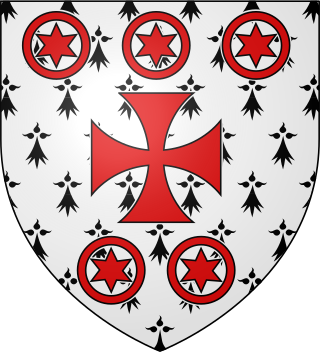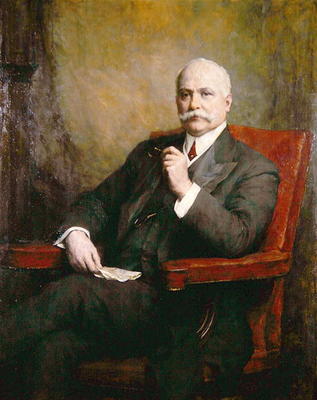
Earl Ferrers is a title in the Peerage of Great Britain. It was created in 1711 for Robert Shirley, 14th Baron Ferrers of Chartley. The Shirley family descends from George Shirley of Astwell Castle, Northamptonshire. In 1611 he was created a Baronet, of Staunton Harold in the County of Leicester, in the Baronetage of England. He was succeeded by his son Henry, the second Baronet, who married Lady Dorothy Devereux, daughter of Robert Devereux, 2nd Earl of Essex. On the death of her brother Robert Devereux, 3rd Earl of Essex, she became the youngest co-heir to the baronies of Ferrers of Chartley and the barony of Bourchier, which had fallen into abeyance on the death of the third Earl. Shirley was succeeded by his eldest son, the third Baronet. He died unmarried and was succeeded by his younger brother, the fourth Baronet. He was imprisoned in the Tower of London by Oliver Cromwell and died there in 1656. On his death the title passed to his eldest son, the fifth Baronet. He died at an early age and was succeeded at birth by his posthumous son, the sixth Baronet.

Earl of Dudley, of Dudley Castle in the County of Stafford, is a title that has been created twice in the Peerage of the United Kingdom, both times for members of the Ward family.

Viscount De L'Isle, of Penshurst in the County of Kent, is a title in the Peerage of the United Kingdom. It was created in 1956 for William Sidney, 6th Baron de L'Isle and Dudley, VC, KG, GCMG, GCVO (1909–1991).

Baron Banbury of Southam, in the County of Warwick, is a title in the Peerage of the United Kingdom. It was created in 1924 for the businessman and Conservative politician Sir Frederick Banbury, 1st Baronet. He was head of Frederick Banbury and Sons, stockbrokers, and also represented Peckham and the City of London in the House of Commons. Banbury had already been created a baronet, of Southam in the County of Warwick, in 1902. The titles are currently held by his great-grandson, the third Baron, who succeeded his father in 1981.

Baron Brain, of Eynsham in the County of Oxford, is a title in the Peerage of the United Kingdom. It was created on 26 January 1962 for the physician and neurologist Sir Russell Brain, 1st Baronet. He had already been created a Baronet, of Reading in the County of Berkshire, on 29 June 1954. As of 2014 the titles are held by his youngest son, the third Baron, who succeeded in that year. He is a retired physician and a former professor of medicine at McMaster University, Canada.

Baron Croft, of Bournemouth in the County of Southampton, is a title in the Peerage of the United Kingdom. It was created on 28 May 1940 for the Conservative politician Sir Henry Page Croft, 1st Baronet. He had already been created a baronet of Knole in the Borough of Bournemouth in the County of Southampton in the Baronetage of the United Kingdom on 28 February 1924. Croft was the grandson of Reverend Richard Croft, third son of Dr. Sir Richard Croft, 6th Baronet, of Croft Castle. As of 2010 the titles are held by the first Baron's grandson, the third Baron, who succeeded his father in 1997.
Baron Rathcavan, of The Braid in the County of Antrim, is a title in the Peerage of the United Kingdom. It was created on 11 February 1953 for the Unionist politician Sir Hugh O'Neill, 1st Baronet. He had already been created a Baronet, of Cleggan in the County of Antrim, on 17 June 1929. O'Neill was the third son of Edward O'Neill, 2nd Baron O'Neill and the uncle of the Prime Minister of Northern Ireland Terence O'Neill, Baron O'Neill of the Maine. Lord Rathcavan was also a male-line descendant of Edward Chichester, 1st Viscount Chichester. He was succeeded by his eldest surviving son, the second Baron. He succeeded his father as Unionist Member of Parliament for Antrim in 1952, a seat he held until 1959, and was later a member of the Parliament of Northern Ireland. As of 2014 the titles are held by his son, the third Baron, who succeeded in 1994.

There have been two baronetcies created for persons with the surname Arthur, both in the Baronetage of the United Kingdom. As of 2014 both creations are extant.

There have been two baronetcies created for members of the Bowater family, both in the Baronetage of the United Kingdom. Both creations are extant as of 2010.

There have been three baronetcies created for persons with the surname Holden, all in the Baronetage of the United Kingdom. Two of the creations are extant as of 2010.
The Dudley-Williams Baronetcy, of the city and of the county of the city of Exeter, is a title in the Baronetage of the United Kingdom. It was created on 2 July 1964 for the aeronautical engineer and Conservative politician Sir Rolf Dudley-Williams. On receiving the baronetcy, on 29 June 1964 Williams changed his surname to Dudley-Williams by deed poll. As of 2010 the title is held by his son, the 2nd Baronet, who succeeded in 1987.

There have been two baronetcies created for members of the Waterlow family, both in the Baronetage of the United Kingdom. Both titles are extant as of 2010.
The Batho Baronetcy, of Frinton in the County of Essex, is a title in the Baronetage of the United Kingdom, and was created on 19 October 1928 for Sir Charles Albert Batho. He was educated at Highgate School from 1882 to 1885, was an Alderman of the City of London from 1921 to 1938, and Lord Mayor of London from 1927 to 1928. As of 2007, the title is held by his grandson, the third Baronet, who succeeded his father in 1990.
The Studd Baronetcy, of Netheravon in the County of Wiltshire, is a title in the Baronetage of the United Kingdom. It was created on 16 October 1929 for the cricketer and businessman Kynaston Studd. He was the eldest of the famous Studd brothers.

The Gibson, later Gibson-Carmichael, later Gibson-Craig-Carmichael Baronetcy, of Keirhill in the County of Edinburgh, is a title in the Baronetage of Nova Scotia. It was created on 31 December 1702 for Thomas Gibson, with remainder to his heirs male. The sixth Baronet assumed the additional surname of Carmichael. The eleventh Baronet was a Liberal politician. In 1912, he created Baron Carmichael, of Skirling in the County of Peebles, in the Peerage of the United Kingdom. The barony died in 1926, while he was succeeded in the baronetcy by his kinsman Sir Henry Thomas Gibson-Craig-Carmichael, 5th Baronet, of Riccarton, who became the twelfth Baronet of Keirhill and assumed the additional surname of Carmichael.
The Tuck Baronetcy, of Park Crescent in Metropolitan Borough of St Marylebone, is a title in the Baronetage of the United Kingdom. It was created on 19 July 1910 for Adolph Tuck. He was chairman and managing director of Raphael Tuck & Sons Ltd., makers of Christmas cards, picture postcards, et cetera. The Tuck family is of German-Jewish origin. The first Baronet's father Raphael Tuck was born in Prussia and emigrated to the United Kingdom in 1865.
There have been six baronetcies created for persons with the surname Thomas, three in the Baronetage of England, one in the Baronetage of Great Britain and two in the Baronetage of the United Kingdom. Two of the creations are extant as of 2016.
There have been three baronetcies created for persons with the surname Wiseman, all in the Baronetage of England. Only one creation is extant as of 2008.
There have been four baronetcies created for persons with the surname Musgrave, one in the Baronetage of England, one in the Baronetage of Nova Scotia, one in the Baronetage of Ireland and one in the Baronetage of the United Kingdom. As of 2014 two of the creations are extant.
There have been three baronetcies created for persons with the surname Clayton, two in the Baronetage of Great Britain and one in the Baronetage of the United Kingdom. One creation is extant as of 2021.










